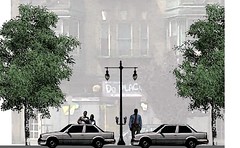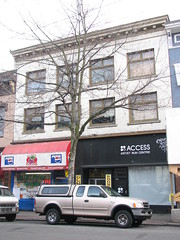The positive and economic contribution of trees
(Flickr image of the Filion Block in Vancouver BC by Bob KH.)
From email:
New DNR Study Shows Hyattsville' s Trees Benefit The Bay, Save On Energy Bills And Mitigate Global Warming
HYATTSVILLE, MD — The Maryland Department of Natural Resources (DNR) Forest Service recently completed a study of Hyattsville' s 2,900 roadside trees. While the 2.5 sq. mile city has the potential for approximately 7,700 street trees, currently 4,800 potential planting sites remain empty.
"Trees not only mitigate greenhouse gases, improve stormwater quality, lower emissions by reducing energy use and improve air quality, but they do all of these things at the same time," said Michael F. Galvin, DNR Urban Forestry Supervisor. "No other environmental mitigation device provides these multiple benefits, in addition to others like aesthetics and wildlife habitat. Improving the condition and extent of tree canopy in urban areas is vital to community livability as our cities grow."
The total annual value of benefits provided by the trees equals $281,389. Each individual tree contributes $96.30 in annual benefits and $18.53 in annual benefits per capita. The study found that Hyattsville' s roadside trees provide the many valuable ecosystem services to city residents including:
* Stormwater management control by intercepting 10.5 million gallons of rainfall annually at a value of $104,818;
* Energy savings by reducing the needs for heating and cooling by 310 MWh of electricity and 10,625 therms of natural gas annually at a value of $44,944;
* Annual sequestration and reduction of over 1.1 million pounds of carbon at a value of $8,428; and
* Air quality improvement by annual reduction of over 500 pounds of smog (ozone) and 500 pounds of soot (particulate matter) at a value of $2,706.
Eighty-six percent of Marylanders live in urban areas. Residents can help by planting trees and helping to maintain local trees by watering them and mulching around the base.
The study aims to help Hyattsville plan for future tree plantings and develop its Urban Tree Canopy Plan. DNR utilized the USDA Forest Service iTREE software to complete the study.
------------------
Similar studies have found a positive connection between trees in commercial districts and sales, as well as property values and lease rates. (I wrote about this a couple years ago in the blog. I'll have to dig up a link to this Forest Service software and add it in the blog.) Still, many retail businesses tend to oppose trees, seeing them as blocking views into their businesses. I think we need to remember that one of the things that distinguishes traditional commercial districts from malls is greenery and a connection to the environment. And the trick is to plant trees that grow to a certain height that doesn't obscure views into ground floor stores--meaning the tree canopy should be above 15 feet.

Proposed streetscape design for H Street NE, produced by the Michael Baker Corporation for the H Street Streetscape and Transportation Study.
Labels: environment, parks, public space management, trees




0 Comments:
Post a Comment
<< Home